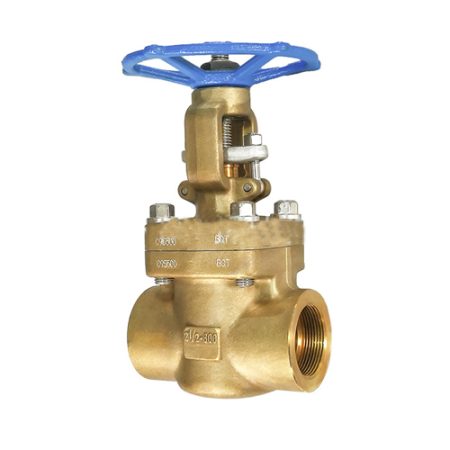
An outside screw and yoke valve lets you see the stem move. You can tell this valve by its rising stem and yoke. You must know the right specifications and features for your job. These details help with safety, performance, and following rules. This valve is not like a butterfly valve or a ball valve. It is used where you need to see if it is open or closed. Some systems, like a pneumatic ball valve, do not show this clearly.
Key Takeaways
- OS&Y valves have a stem you can see. The stem goes up when the valve is open. The stem goes down when the valve is closed. This makes checking the valve fast and easy.
- These valves are used in fire safety systems. They are also used in waterworks and factories. Safety and knowing if the valve is open or closed are very important.
- Pick the right valve size for your system. Make sure the pressure rating fits your needs, up to 300 PSI. Check the temperature rating too, up to 180°F.
- Valve bodies are made from ductile iron, cast iron, bronze, or stainless steel. Each material works best in different places and with different liquids.
- The outside stem and yoke design makes fixing the valve easy. You can grease and repair it without taking the valve out.
- Look for certifications like UL, FM, AWWA, and ASME. These show the valve is safe, good quality, and follows rules.
- Choose the right end connection type for your pipes. It can be flanged, screwed, welded, or another type. Pick what fits your installation.
- Check and take care of your valve often. This stops rust and bolt problems. It keeps your OS&Y valve safe and working well.
Overview
What Is an Outside Screw and Yoke Valve
You can spot an outside screw and yoke valve by its unique design. The stem sits outside the valve body and connects to a yoke. When you turn the handwheel, the stem moves up or down. This movement lets you see if the valve is open or closed. The stem rises when open and lowers when closed. Most other gate valves hide the stem inside the body, so you cannot see the position. The outside screw and yoke design gives you a clear visual indication every time.
Tip: If you need to check the status of a valve quickly, choose an outside screw and yoke valve. You will always know if it is open or closed just by looking at the stem.
Here are the main features that set outside screw and yoke valves apart:
- The stem and yoke sit outside the valve body.
- You get a visible stem position for easy status checks.
- The handwheel attaches to a threaded stem held by the yoke.
- The valve closes slowly, which helps prevent water hammer.
- Many outside screw and yoke valves carry UL and FM approvals for fire protection.
How OS&Y Valves Work
You control flow with os&y valves by turning the handwheel. The yoke holds the stem in place outside the valve body. As you rotate the handwheel, the stem threads move up or down. This action lifts or lowers the gate inside the valve. When the stem rises, the gate opens, and water or fluid flows through. When the stem lowers, the gate closes, stopping the flow. You can always see the stem position, so you know the exact status. This feature makes os&y valves reliable for safety-critical systems.
Note: How os&y valves work helps you avoid mistakes. You do not need to guess if the valve is open or closed. The stem tells you everything.
Main Uses
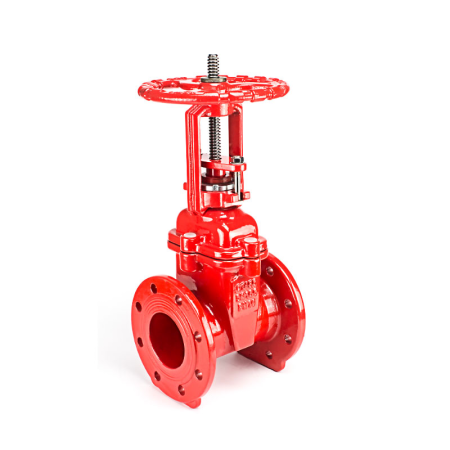
You will find os&y valves in places where safety and clear status matter most. These valves play a key role in fire protection systems, such as sprinkler and standpipe installations. Insurance companies and local codes often require outside screw and yoke valves for these jobs. Waterworks and municipal systems also use os&y valves because they offer easy maintenance and visual checks. Industrial plants rely on outside screw and yoke valves for process control and safety. The slow closing action protects pipes from pressure surges.
Here is a quick table showing common applications:
| Application Area | Reason for Use |
|---|---|
| Fire Protection | Visual status, code compliance |
| Waterworks | Easy maintenance, reliability |
| Industrial Systems | Safety, slow closing action |
You should choose an outside screw and yoke valve when you need a clear, reliable way to control and monitor flow.
Specifications
Size Range
You need to know the size range before you choose an os&y gate valve. Most outside screw and yoke valves come in sizes that fit many fire protection and waterworks systems. You can find os&y gate valves from 2-1/2 inches up to 12 inches. These sizes work well for different pipe diameters and flow needs. The most common connection type is flanged, which follows ANSI B16.1 Class 125 standards. This connection makes installation easy and secure.
Here is a table showing typical size options for os&y gate valves:
| Feature | Details |
|---|---|
| Valve Type | Outside Screw and Yoke (OS&Y) Gate Valve |
| Connection Type | Flanged (ANSI B16.1 Class 125) |
| Available Sizes | 2-1/2″, 3″, 4″, 5″, 6″, 8″, 10″, 12″ |
| Max Working Pressure | 300 PSI |
| Max Working Temperature | 180°F (82°C) |
| Approvals | UL, ULC, FM |
| Specifications | Design and Dimensions conform to AWWA C515 |
You can also see the available sizes in this chart:
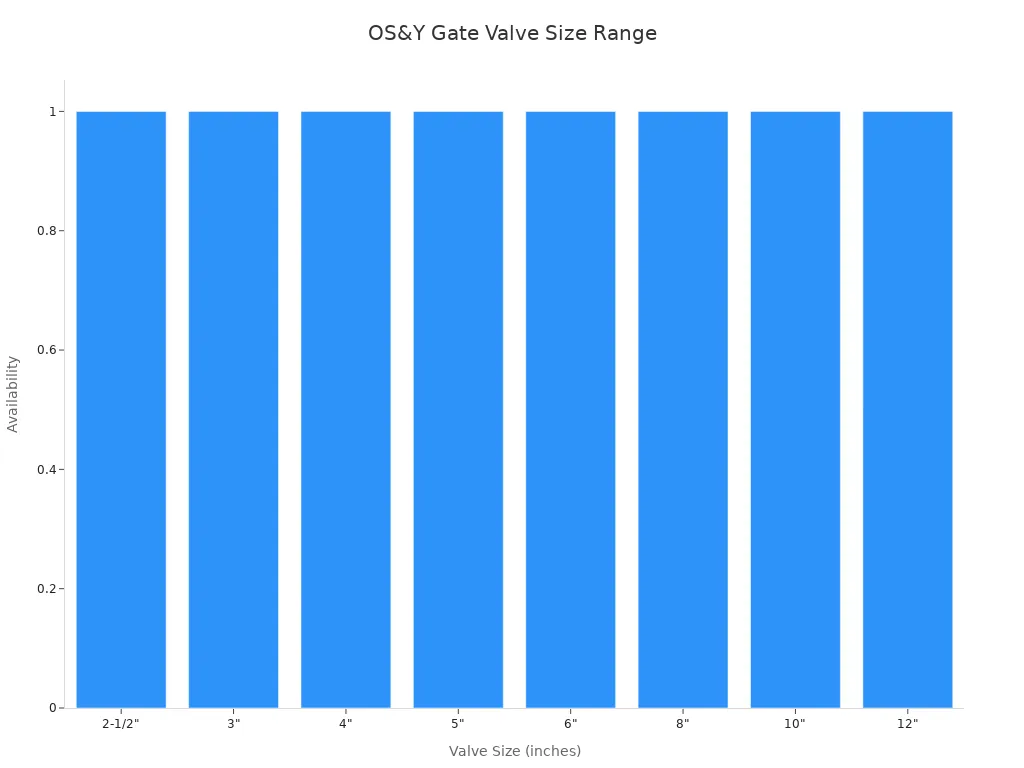
Tip: Always check the size of your pipes before you select an os&y gate valve. The right size helps you avoid leaks and keeps your system safe.
Pressure Ratings
You must check the pressure rating when you pick an os&y gate valve. Most os&y valves for fire protection and waterworks handle up to 300 PSI. This rating means the valve can control high water pressure without failing. You need this strength for safety in fire sprinkler systems and municipal water lines. If you use a valve with a lower rating, you risk leaks or damage.
Pressure ratings tell you how much force the valve can handle. You should match the pressure rating to your system’s needs. If your system runs at high pressure, choose an os&y gate valve with a 300 PSI rating. This choice keeps your pipes and equipment safe.
Note: Pressure ratings matter for insurance and code compliance. Always use os&y gate valves with the right rating for your job.
Temperature Ratings
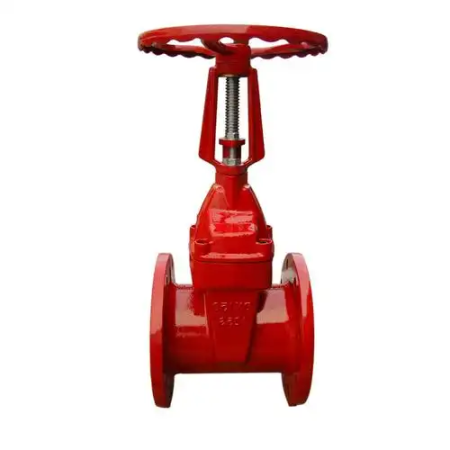
You must know the temperature rating for every os&y gate valve you install. Most outside screw and yoke valves work up to 180°F (82°C). This rating covers most fire protection and waterworks jobs. If your system runs hotter, you need a valve with a higher temperature rating.
Temperature ratings show how much heat the valve can handle before it fails. You should check the temperature of your water or fluid before you choose an os&y gate valve. If you use a valve with a low rating in a hot system, you risk damage and leaks.
Tip: Always match the temperature rating of your os&y gate valve to your system. This step helps you avoid problems and keeps your system running smoothly.
Materials
Body Materials
You need to choose the right body material for your outside screw and yoke valve. The body forms the main structure and faces the most stress. Most OS&Y valves use ductile iron or cast iron for the body. These metals give you strength and resist corrosion. Some valves use bronze or stainless steel for special jobs. Bronze works well in smaller valves and resists rust. Stainless steel handles harsh chemicals and high temperatures.
- Ductile Iron: Strong and flexible. It resists cracking and works well in water systems.
- Cast Iron: Common in older valves. It is heavy and strong but can break under impact.
- Bronze: Good for small valves. It resists corrosion and lasts a long time.
- Stainless Steel: Best for tough jobs. It stands up to chemicals and heat.
Tip: Always match the body material to your system’s needs. If you work with drinking water, look for valves certified to ANSI/NSF 61 & 372. These standards make sure the valve does not add harmful substances to the water.
Stem and Yoke
The stem and yoke are key moving parts in an OS&Y valve. The stem connects the handwheel to the gate inside the valve. The yoke holds the stem in place and guides its movement. You want these parts to last and work smoothly.
- Stem: Most stems use stainless steel. This metal resists rust and keeps the stem strong, even after years of use. Some stems use bronze for smaller valves.
- Yoke: The yoke often uses the same metal as the body. For example, a ductile iron body will have a ductile iron yoke. This keeps the valve strong and stable.
You should check the stem and yoke for smooth movement. If the stem sticks or rusts, the valve may not open or close fully. A strong yoke keeps the stem straight and helps the valve last longer.
Standards
You must follow the right standards when you select an OS&Y valve. Standards make sure your valve is safe, reliable, and legal for your job. The most common standards for OS&Y valves include:
- ANSI/AWWA C550 for epoxy coating requirements
- ASME/ANSI B16.1 Class 125 for flanged end drilling
- UL 262 Listing and FM 1120/1130 Approval for fire protection
- ANSI/NSF 61 & 372 for drinking water safety
These standards come from trusted groups like AWWA and ASME. They set the rules for how valves should be made and tested. When you see these marks, you know the valve meets strict quality checks.
Note: Always check for these standards before you buy. Many jobs, like fire protection or drinking water, require valves with these approvals.
End Connections
You have several choices for end connections on OS&Y valves. The end connection affects how you install the valve and how well it seals. Each type works best for certain jobs and pipe sizes.
| End Connection Type | Description & Application | Installation Effects & Considerations |
|---|---|---|
| Screwed | Female pipe threads, used mostly for pipe sizes ≤150mm, common in bronze valves. | Easy to assemble, best for small, low-pressure systems. Joint depends on thread quality. |
| Flanged | Bolted to pipe flanges with a gasket. Sizes from 15mm and up. | Simple to install and remove. Good for frequent maintenance. Gasket type affects sealing. |
| Socket Weld | Valve ends socketed for plain-end pipe, welded outside. Used on steel valves ≤50mm. | Permanent joint, not for frequent removal. Keeps weld spatter out of pipe. |
| Butt Weld | Ends beveled to match pipe, welded at bevels. Used on steel valves ≥50mm. | Strong, permanent joint. Needs precise welding. Not for frequent removal. |
| Compression | Socket with union nut compressing ring onto pipe. Used with copper/steel tubing ≤65mm. | Easy to take apart. Good for low pressure and frequent changes. |
| Capillary | Soldered socket joint, used with copper tubing ≤65mm. | Permanent joint. Limited by solder melting point. Common in plumbing. |
| Socket | Ends socketed for spigot pipe end, sealed with ring. Common in cast iron valves ≥50mm. | Good for water services. Allows some movement in seal. |
| Spigot | Pipe end fits into socket or joint. Used with cast iron valves ≥50mm. | Matches pipe joint type. Installation depends on joint style. |
You should pick the end connection that matches your pipe type and job needs. Flanged ends work well for most fire protection and waterworks jobs. Screwed ends fit small pipes. Welded ends give you a strong, leak-proof joint for high pressure or heat.
Tip: The right end connection makes installation easier and keeps your system safe. Always check your pipe size and pressure before you choose.
Features
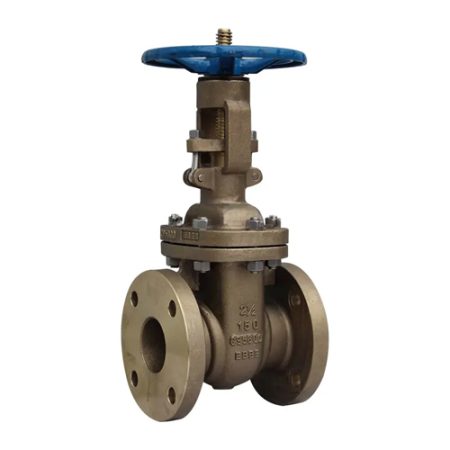
Stem Design
External Threading
You can see the threads on the stem outside the valve. This makes it easy to check them. The threads connect with the yoke nut. This moves the gate up and down. You control the flow with smooth movement. The stem outside lets you see the valve’s position. You know if the valve is open, closed, or in between by looking at the stem.
External threading helps the valve work better. You can add grease to the stem without taking the valve apart. The stem does not rust inside the valve body. This helps the valve last longer. The yoke holds the stem steady. This gives you easy control and less damage. This design is important for fire protection. You need to check the valve fast in emergencies.
Tip: Check the threads for smooth movement and clean surfaces. This helps you keep control and makes sure your valve works when needed.
Rising Stem
The rising stem is a main part of every os&y gate valve. When you turn the handwheel, the stem goes up as the valve opens. The stem goes down when the valve closes. You see the stem rise above the yoke. This shows you where the gate is inside. You get a clear sign, so you never have to guess.
Rising stem designs make fixing the valve easier. You can check the stem and threads without opening the valve. Adding grease is easy because the stem is outside the fluid. The stem does not touch water or other fluids. This stops rust and keeps the stem strong. The rising stem gives you more control. It helps you avoid mistakes in important systems.
Here is a table that compares rising stem and non-rising stem designs:
| Aspect | Rising Stem Design | Non-Rising Stem Design |
|---|---|---|
| Transmission Mode | Handwheel turns nut; stem moves up or down. | Handwheel and stem turn together; stem stays in place. |
| Structure | Stem nut on bonnet or yoke; stem moves outside valve. | Stem nut inside valve body; stem turns but does not move up or down. |
| Installation Space | Needs more room above valve for stem movement. | Small size; needs less space. |
| Lubrication & Durability | Stem threads greased outside; easy to fix; position easy to see. | Threads touch fluid; harder to fix; position hard to see. |
| Application Scope | Best for seeing position and easy greasing. | Used where space is tight; not easy to fix. |
Note: Pick a rising stem os&y gate valve when you want to control flow and see the valve position quickly.
Yoke Structure
The yoke is the frame that holds the stem above the valve. You find the yoke on every os&y gate valve. It keeps the stem straight when you turn the handwheel. The yoke holds the stem nut. This moves the gate up and down. The yoke gives you steady control. It stops bending or problems with the stem.
You can check the yoke easily because it is outside the valve. The open frame lets you look for damage or rust. You can add grease and clean it with no trouble. The yoke helps you take care of the valve. It keeps the valve working well for a long time.
Tip: Look at the yoke during regular checks. A strong yoke means you get safe and steady control.
Visual Indication
You always know the status of an os&y gate valve because you can see it. The stem outside shows if the valve is open, closed, or partway open. You do not need to guess or open the valve. Just look at the stem.
- The stem with threads sits above the valve body.
- The stem goes up when the valve opens and down when it closes.
- You see the stem position clearly, so you can control the system.
- The yoke holds the stem and keeps movement smooth.
- You get quick proof of valve status, which is important for fire safety and emergencies.
This visual sign makes things safer and more reliable. You can act fast in emergencies because you know the position of every os&y gate valve.
Note: Use the visual sign to check valve status before you start fixing or testing. This helps you avoid mistakes and keeps your system safe.
Maintenance Access
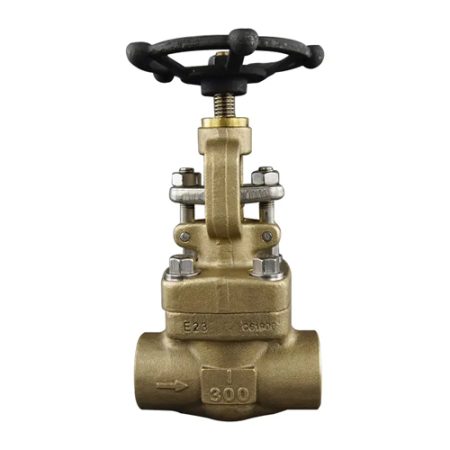
You need to reach your outside screw and yoke valve fast. This helps you check and fix it easily. The design saves you time when you do maintenance. You can handle repairs with these features:
- The bolted bonnet lets you take off the top quickly. You do not need special tools for this job.
- You get direct access to the inside parts. You can look at the stem, gate, and seals without taking apart the whole valve.
- You can check and clean the valve easily. You spot problems early and fix them before they get worse.
- The open yoke gives you room to add grease or change worn parts. You do not have to remove the valve from the pipe.
- You can plan when to do maintenance. Fast access means your system does not stop for long.
Tip: Check your OS&Y valves often. Quick access helps you keep your system safe and working well.
Sealing
You must stop leaks in your outside screw and yoke valve. This is very important when pressure is high. The sealing parts help you keep fluid inside and protect your system. Here is a table that shows common ways to seal the valve:
| Sealing Mechanism | Description |
|---|---|
| Triple O-Rings Stem Seal | Stops leaks around the stem, even when pressure is high. |
| Packing (Flexible Graphite) | Goes around the stem to block fluid; made of graphite or PTFE. |
| Bonnet Gasket (NBR/EPDM) | Seals the space between the bonnet and valve body. |
| Packing Gland | Holds packing tight around the stem to make sealing better. |
You can stop leaks by picking the right seal for your job. Triple O-rings protect the stem well. Flexible graphite packing blocks fluid and handles heat. Bonnet gaskets seal the joint between the body and bonnet. The packing gland keeps everything tight. You must check these seals when you do maintenance to stop leaks and keep your system safe.
Note: Always use the sealing method that fits your pressure and fluid. Good sealing helps your system work well.
Supervisory Switches
You need to watch and control your fire protection system all the time. Supervisory switches on OS&Y valves help you do this. These devices give you quick feedback and make things safer. You can keep your system ready with these features:
- Supervisory switches check the valve position and show when it is not open. You get updates all the time.
- The switches are weatherproof and hard to tamper with. You keep your system safe in tough places.
- Two SPDT contacts send signals to alarms or monitors when the valve moves. You know if someone closes the valve.
- The switch attaches right to the valve and works with the moving parts. You get clear position checks and control.
- Tamper-resistant screws need special tools to remove. You control who can change the switch.
- UL and FM approvals show the switches work well for fire protection. You meet safety and insurance rules.
Tip: Use supervisory switches to watch every OS&Y valve in your fire system. You get quick alerts and keep your system ready for emergencies.
Advantages and Limitations
Benefits
You get many advantages when you choose an os&y gate valve for your system. These valves stand out because of their design and reliability. Here are some key os&y valve benefits:
- You can see the stem move up and down, so you always know if the valve is open or closed.
- The yoke holds the stem steady, which makes the valve easier to operate and more reliable.
- Maintenance is simple. You can grease or replace the stem without taking apart the whole valve.
- The stem threads stay outside the fluid path. This keeps them safe from rust and corrosion, especially in tough environments.
- The handwheel connects to a bushing on the yoke, which helps the stem move smoothly.
- These features make the os&y gate valve a top choice for fire protection and water treatment plants, where you need quick checks and easy repairs.
Tip: If you want a valve that is easy to check and maintain, the os&y gate valve is a smart pick.
Drawbacks
You should also know the limits of an os&y gate valve. In some industrial settings, the bolts in the valve bonnet can fail. This happens when bolts crack or break because of stress corrosion. Humid and salty air, like in marine areas, can make this problem worse. Corrosion often starts at small pits near the bolt head. Over time, this weakens the bolts and can cause leaks or even valve failure. You need to check the bolts often, especially if your system faces harsh weather or chemicals. Bolt problems show that you must pay attention to valve maintenance in tough environments.
Note: Always inspect the bolts and yoke for signs of rust or damage. This helps you catch problems early and keep your os&y gate valve working well.
Comparison
You may wonder how an os&y gate valve compares to other types. The table below shows the main differences between os&y gate valves and non-rising stem (NRS) gate valves:
| Feature | OS&Y Gate Valve | Non-Rising Stem Gate Valve |
|---|---|---|
| Stem Visibility | Stem moves up/down, easy to see status | Stem stays in place, hard to see |
| Maintenance | Easy to grease and repair | Harder to service |
| Corrosion Protection | Stem threads outside fluid | Threads inside, more corrosion |
| Space Needed | Needs more room above valve | Fits in tight spaces |
| Best Use | Fire protection, water treatment | Underground or space-limited jobs |
You get better visibility and easier maintenance with an os&y gate valve. NRS valves work better when you have little space. Both types have their place, but you should pick the one that fits your needs best.
Certifications
Common Certifications for OS&Y Valves
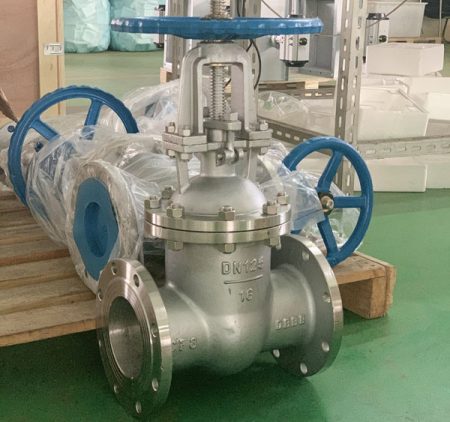
When you pick an OS&Y valve, you should look for special certifications. These marks show the valve is safe and high quality. Here are the main certifications you need to know:
UL
UL checks valves to make sure they work in fire protection. If you see a UL mark, the valve passed hard fire safety tests. Many fire rules say you must use UL-listed valves.
FM
FM Approval means the valve meets insurance and safety rules. FM tests valves for strength and how well they work. You often need FM-approved valves for fire sprinkler systems.
AWWA
AWWA makes rules for valves used in water systems. If a valve meets AWWA rules, you can trust it for city water pipes. Look for AWWA C515 or C509 on the valve or in the papers.
ASME
ASME rules cover how valves are made and tested. ASME B16.1 and other codes make sure the valve fits and works under pressure. ASME marks show the valve meets industry rules.
Importance of Certifications
Certifications are important for many reasons. You keep people and property safe when you use certified valves.
Ensuring Safety and Reliability
Certified valves go through tough tests. These tests check for leaks, strength, and safe use. You can trust a certified valve to work when needed.
Regulatory Compliance
Many local rules and insurance companies want certified valves. If you use a valve without the right mark, you might fail inspections. You could also lose insurance.
Market Acceptance
Certified valves are easier to buy and sell. Contractors and inspectors look for these marks. You save time and avoid trouble by picking certified products.
Tip: Always look for UL, FM, AWWA, or ASME marks before you buy an OS&Y valve. These marks help you follow rules and keep your system safe.
How to Identify Certified Valves
You need to know how to find a certified valve. Here are three ways to check:
Certification Marks and Labels
Look for marks or labels on the valve body or handwheel. You might see “UL Listed,” “FM Approved,” or “AWWA C515.” These marks are often stamped or cast into the metal.
Manufacturer Documentation
Ask for the valve’s papers. The maker should give you certificates or test reports. These papers list all the rules the valve meets.
Third-Party Listings
Check online lists from UL, FM, or AWWA. You can search for the valve model and see if it is listed. This step gives you extra proof the valve is certified.
| Certification | Where to Find It | Why It Matters |
|---|---|---|
| UL | Valve label, UL website | Fire safety, code compliance |
| FM | Valve label, FM website | Insurance, reliability |
| AWWA | Valve body, documents | Waterworks, public safety |
| ASME | Valve body, documents | Industry standards, fit |
Note: Certified OS&Y valves are often needed for fire protection and city water systems. Always check before you install.
Application Suitability
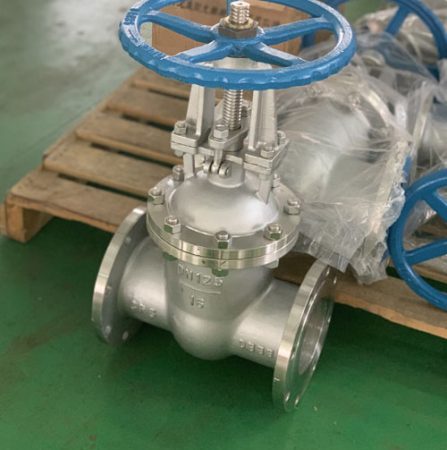
Fire Protection
You see os&y valves in almost every fire safety system. These valves help control water and protect buildings. You can look at the stem to check if the valve is open or closed. This makes it easy to act fast in an emergency. You do not have to guess the valve’s position. The stem goes up when open and goes down when closed. This is why os&y valves are picked for fire protection.
You find these valves in fire sprinklers and standpipes. The strong build stops people from closing the valve by mistake or on purpose. Tamper-resistant parts keep your system safe. NFPA codes say you must secure control valves so no one can turn them off without permission. OS&Y valves follow these rules and keep your fire system ready. You get good performance and long-lasting safety.
Tip: Always look at the stem before you test or fix your fire system. Quick checks save time and help you avoid mistakes.
Why choose os&y valves for fire protection?
- You can see the valve’s status right away.
- The design stops people from closing it without permission.
- You meet NFPA safety rules.
- The valve is tough and lasts a long time.
Waterworks
You use os&y valves in waterworks to control water in city pipes and plants. These valves help you manage water and keep things working well. The rising stem lets you see if the valve is open or closed. You do not need special tools to check the position. This makes your job faster and easier.
Waterworks need strong valves for high pressure and hard jobs. OS&Y valves have a sturdy body and a reliable stem. You can grease the stem and fix problems without taking out the valve. This saves time and keeps water service steady. You also follow local rules and standards with these valves.
| Waterworks Application | Why Use OS&Y Valve? |
|---|---|
| City water mains | Easy control and checks |
| Treatment plants | Reliable operation |
| Pump stations | Quick maintenance access |
Note: Check your valves often and do simple repairs. This keeps your water system safe and working well.
Industrial Use
You find os&y valves in many factories and plants. These valves help control fluids in chemical plants and power stations. The visible stem lets you check the valve quickly. You can act fast if you need to stop or start flow.
Industrial systems need valves that do not rust and can handle heat. OS&Y valves use strong metals like stainless steel and ductile iron. You can add grease and check moving parts without stopping the whole system. This keeps your plant running and cuts down on downtime.
You use os&y valves for water, steam, chemicals, and other fluids. The design helps stop leaks and keeps your process safe. You also meet safety codes and industry rules with these valves.
Tip: Pick os&y valves for factory jobs where you need quick control and easy repairs.
Firefighting Applications
You find OS&Y valves in almost every firefighting system. These valves help keep people and buildings safe. You see them in fire sprinkler and standpipe systems. They are at important control spots. You can spot them in fire pump rooms and main water lines.
Where do you use OS&Y valves in firefighting?
- Fire sprinkler system main control valves
- Standpipe system isolation valves
- Fire pump test headers
- Backflow preventer assemblies
- Fire department connections
People pick OS&Y valves for firefighting because you can see if the valve is open or closed. The rising stem shows you the position. You do not have to guess. This helps you act fast in an emergency. Firefighters and inspectors check the stem quickly.
Tip: Always look at the stem before you test or fix a fire system. The visible stem helps you avoid mistakes.
Why do fire codes require OS&Y valves?
Fire codes like NFPA 13 and NFPA 25 have rules for fire sprinkler systems. These rules say you must use valves that show their position. OS&Y valves follow this rule. Insurance companies and fire marshals want you to use these valves too. You get better safety and easier checks.
Here is a table showing how OS&Y valves help you meet firefighting standards:
| Requirement | How OS&Y Valves Help |
|---|---|
| Visual position indication | Rising stem shows open/closed status |
| Tamper resistance | Supervisory switches detect changes |
| Reliable shutoff | Strong yoke and stem design |
| Code compliance | Meets NFPA, UL, and FM standards |
Some OS&Y valves have supervisory switches. These switches send signals to fire alarms if someone closes the valve. You get an alert right away. This keeps your fire system ready all the time.
Key benefits for firefighting:
- Quick visual checks save time in emergencies.
- Tamper-resistant features stop unauthorized changes.
- Easy maintenance keeps your system working.
- Certified valves help you pass inspections.
Note: Always use OS&Y valves with UL and FM approvals for fire protection. These marks show the valve passed strict tests.
You protect lives and property when you pick the right OS&Y valve for firefighting. The clear design, strong build, and code compliance make these valves the best choice for fire safety systems.
OS&Y Valve Selection
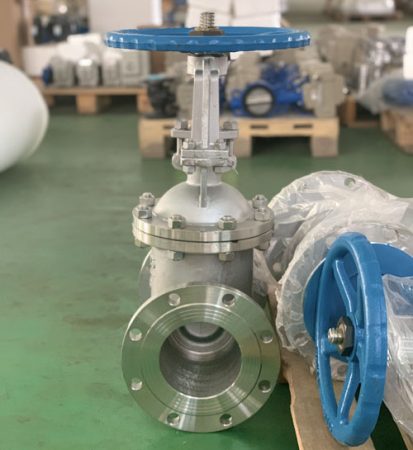
Selection Steps
You want to pick the right os&y for your system. Follow these steps to make a smart choice:
- Check the Pipe Size
Measure your pipes. Match the os&y size to your pipe diameter. This helps you avoid leaks and keeps your system safe. - Know Your Pressure Needs
Find out the maximum pressure in your system. Choose an os&y that can handle this pressure. Most valves work up to 300 PSI. - Look at Temperature Ratings
Check the highest temperature your system reaches. Pick an os&y that works at this temperature. - Select the Right Material
Choose a valve body that fits your job. Ductile iron works for water. Stainless steel fits chemical jobs. - Review Certifications
Make sure your os&y has UL, FM, AWWA, or ASME marks. These show the valve meets safety rules. - Pick the Best End Connection
Match the end connection to your pipes. Flanged ends work for most fire and water jobs.
Tip: Use this checklist every time you select an os&y. You will get a valve that fits your needs and follows the rules.
Key Factors
You need to think about several key factors when you choose an os&y. These factors help you control flow and keep your system safe.
| Factor | Why It Matters |
|---|---|
| Size | Matches your pipe and flow needs |
| Pressure Rating | Handles system pressure safely |
| Material | Resists rust and damage |
| Certification | Meets safety and code requirements |
| End Connection | Fits your installation style |
| Visual Indication | Lets you control and check status fast |
You should always check for compliance with standards like AWWA, UL/FM, and ASME. These standards make sure your os&y will work in fire protection, waterworks, or industrial control systems.
Note: Picking the right os&y helps you control water, meet codes, and avoid problems.
Common Mistakes
You can avoid trouble by knowing the common mistakes people make when choosing an os&y.
- You pick the wrong size. This causes leaks or poor control.
- You forget to check pressure ratings. The valve may fail under high pressure.
- You choose the wrong material. Rust or damage can happen fast.
- You skip certification. Your system may not pass inspection.
- You ignore end connections. Installation becomes hard or unsafe.
- You do not check for visual indication. You lose control over valve status.
Tip: Always double-check your choices. The right os&y gives you safe control and easy maintenance.
You have learned the main features and details about OS&Y valves. When picking a valve, check the size and pressure rating. Make sure you look at the material and certifications too. These steps help keep your system safe and working well.
- Pick a valve that fits what your job needs.
- Choose one with a stem you can see and that is easy to fix.
Remember: Use this guide whenever you pick or work on OS&Y valves. Good choices help make your system safer.
FAQ
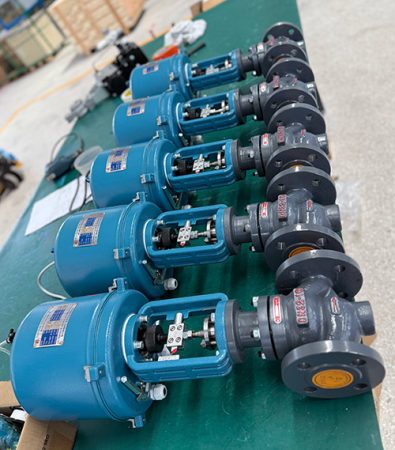
What does OS&Y stand for?
OS&Y means “Outside Screw and Yoke.” You see the stem move outside the valve body. The yoke holds the stem steady. This design helps you check if the valve is open or closed.
How do you know if an OS&Y valve is open?
Look at the stem. If the stem rises above the yoke, the valve is open. If the stem lowers, the valve is closed. You do not need tools to check the position.
Where should you use OS&Y valves?
You use OS&Y valves in fire protection, waterworks, and industrial systems. These valves work best when you need to see the valve’s status quickly and keep your system safe.
Why do fire codes require OS&Y valves?
Fire codes want you to use valves that show their position. OS&Y valves have a rising stem you can see. This helps you follow safety rules and pass inspections.
How often should you check OS&Y valves?
You should check OS&Y valves every month. Look for rust, leaks, or damage. Grease the stem if needed. Regular checks help you keep your system working well.
What certifications should you look for on OS&Y valves?
You need to find UL, FM, AWWA, or ASME marks. These show the valve passed safety tests. Certified valves help you meet rules and keep your system safe.
Can you repair an OS&Y valve without removing it?
Yes, you can fix many parts without taking out the valve. The open yoke and bolted bonnet let you reach the stem and seals easily. This saves you time during maintenance.
Tip: Always follow the manufacturer’s instructions when you repair or check your OS&Y valve.
